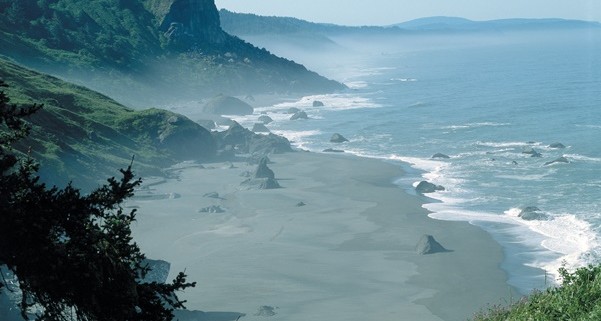Opinion
A coastal tale: Why developers love farmers
 The California coast along Redwood National Park, north Humboldt County, (Photo: Don Forthuber, redwoods.info)
The California coast along Redwood National Park, north Humboldt County, (Photo: Don Forthuber, redwoods.info)It’s been a year since I resigned from the California Coastal Commission, and it’s time to tell a few stories of what I learned as a Coastal Commissioner. Each and every month I learned that not everything was how it seemed.
My first lesson was learning that developers love farmers.
In fact, developers think farms and farmers are the best thing to ever happen to the coast of California. Developers love buying farms. They buy-out family farms for prices that far exceed what the farmers could ever get from selling their crops. And often developers let the farmer stay on the farm, leasing them back the land so they can continue to farm it. Developers even help farmers optimize their output by making sure that they plant multiple crops each year and insisting that each time they plant they till each and every inch of their fields. And the farmers are told to make sure the fields are perfectly level so no water can collect or pond on the fields, regardless of how small.
When I first ran into this I thought, “Wow what a great deal. The developers are helping farmers maximize their yields by making all these improvements to California farming. “
Boy was I dumb.
The developers knew that if the farm fields were to remain fallow, many of them would return to the native wetlands or sensitive habitats that are protected by the Coastal Act and when that happened, developers couldn’t build on them. If enough of the farm would be found to have ESHA or Wetland, it would limit the number of houses that could be built (reducing the value of the project) or might even make the entire project economically unfeasible.
The reality was that the real estate developers could care less about farming or the crops. Tilling every inch of the farm and pouring pesticides on it meant nothing but a single crop could grow. Making it perfectly level meant that no water could pool and start a wetland. Developers were using the farmers to ensure the continued eradication of any Environmentally Sensitive Habitat Area (ESHA) or Wetland.
So the developers keep the farmers plowing the fields as the developers work on changing the zoning and getting approvals, and when they do, the bulldozers show up to start building the condos or houses that have buried Southern California. And the farmers retire.
That’s why developers on the California coast love farming.
Lessons Learned:
–The Coastal Act prohibits development in Environmentally Sensitive Habitat Areas (ESHA) or Wetland.
–Existing farms have previously eradicated ESHA or Wetland.
–Keeping the farming going while developers get approvals minimizes environmental objections.
—
Ed’s Note: Steve Blank, a high-technology entrepreneur and author, is a former member of the California Coastal Commission, appointed in 2007.
Want to see more stories like this? Sign up for The Roundup, the free daily newsletter about California politics from the editors of Capitol Weekly. Stay up to date on the news you need to know.
Sign up below, then look for a confirmation email in your inbox.

Wait! I’ve had an epiphany! There is a conspiracy between developers and farmers to keep land from turning into wetlands, including Steve Blank’s 3-story, 15,760 square foot, 31 foot high residence, with 6,000 square feet underground including underlying tunnels that could have been a wetland or pond, a 21-foot high barn, a 3,040 square foot horse stable, a 1,250 square foot 24 foot high farm labor housing unit all on a 261-acre agricultural parcel in Pescadero. Included in the Coastal Commission Development Permit to Blank was a drainage plan to “reduces runoff from entering the unnamed drainage in Deluca Valley or any other riparian or wetland area.” Further, the proposed development “runoff…shall be collected and discharged to avoid ponding.”
Blank’s development project is “located inland of State Highway 1 about six miles south of Pescadero…State land surround the property on the east, north, and west and State Coastal Conservancy land are on the south side.” “The 261-acre property is known as K&S Ranch…existing uses on the property include a farm labor housing unit, caretaker’s trailer…agricultural fields and undeveloped land (Biotic Resources Group 2000).” “A Natural Resource and Agricultural Conservation Easement held by the State Coastal Conservancy applies to the Cascade Valley Ranch” of which the property is a part.
The property is zoned “Planned Agricultural District/Coastal Development District)” The project includes a septic field area.
This can all be found in Coastal Commission Permit A-2-SMC-00-028, April 12, 2001.